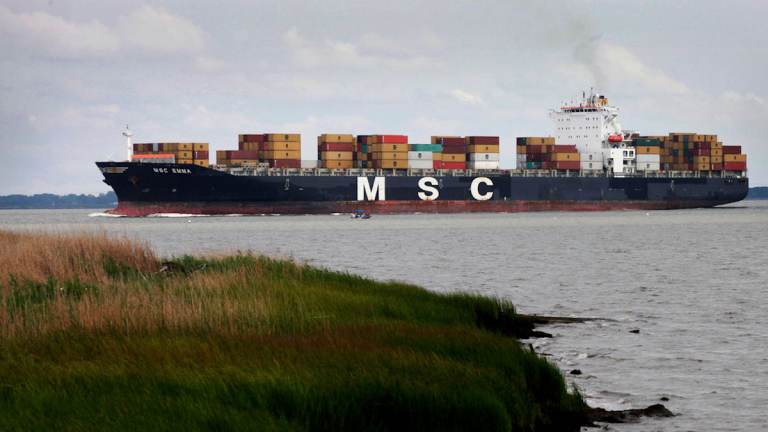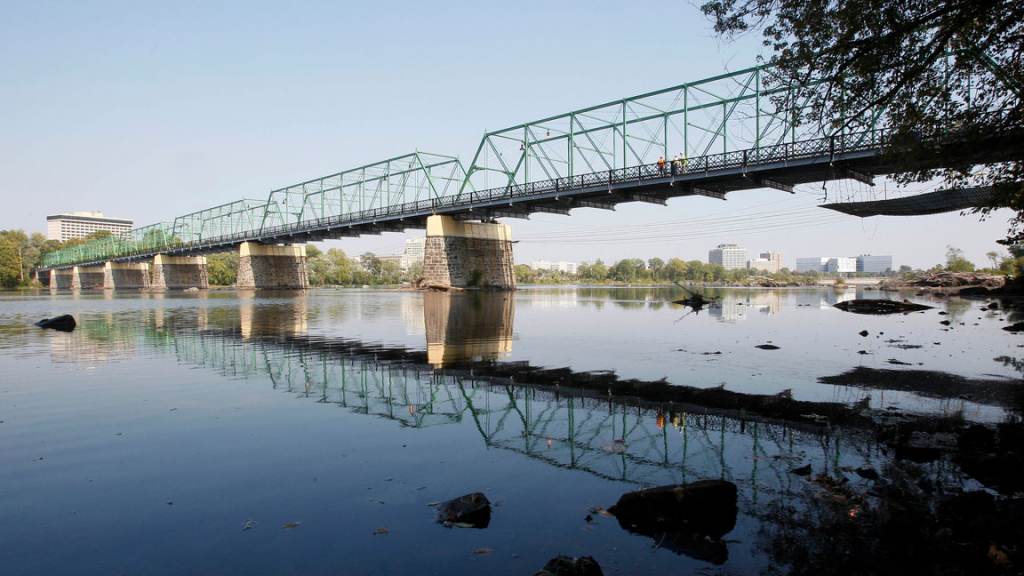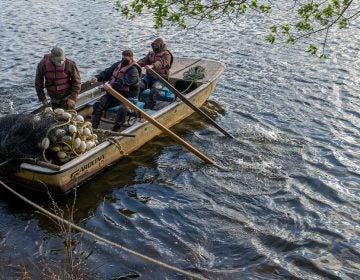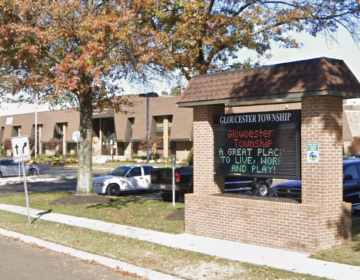Falling short for years, N.J. now pays Delaware River commission its full share
The multistate agency tasked with protecting watershed in four states hasn’t received proper funding in years.

A container ship on the Delaware River. (AP Photo/Mark Lennihan)
This story originally appeared on NJ Spotlight.
When the Delaware River Basin Commission was created in 1961, New Jersey, Pennsylvania, New York and Delaware — the four states that encompass the land, wetlands and more than 2,000 tributaries that make up the the13,600 square-mile watershed — each agreed to pay a percentage of the authority’s annual operational budget.
But since 2013, New Jersey has fallen short, missing its contribution by $200,000 annually. Under its agreement with the other states, New Jersey was to pay 25% of the costs to run the commission, a share of $893,000.
Pennsylvania and New York have failed to come up with their share, too. And save for one earmark under the Obama administration, the federal government, which is supposed to pay $715,000 in yearly operational expenses, has contributed nothing since 1996.
“That’s about a $16 million shortfall from the federal government alone,” said Peter Eschbach, communication director for the commission.
In 1988, the states agreed to split an annual contribution of just over $2.8 million to go toward the commission’s operational costs. Because New Jersey and Pennsylvania hold the most land and population within the watershed, they were on the hook for 25% each, or $893,000 per year. New York agreed to pay 17.5% and Delaware 12.5%. The federal government would kick in 20%
For New Jersey, at least, the time has finally come to pay up in full. In this year’s record $46.4 billion budget, legislators slated the full share for the commission.
Increased agility
For the commission, said Eschbach, the increased funding from New Jersey means a step toward adding to its skeleton staff of 35 and continuing its core work: managing water quality and supply within the watershed. But it also means having the ability to be more agile for the uncertain future.
“Emerging issues are popping up all the time,” Eschbach continued, pointing to the increased frequency of drought, extreme heat and severe storms as added stressors on the watershed, which supplies over 13 million people — about 4% of the U.S. population — with drinking water.
The creation of the Delaware River Basin Commission came at a critical moment for the river and region’s environmental health.
Even before the nation’s inception, the Delaware River’s water quality suffered from unmitigated effluent from tanneries, slaughterhouses and paper mills. In 1739, a young Ben Franklin led a community effort in Philadelphia to remove these polluters from the riverfront. In his estate, Franklin left money for the city to develop what would become the nation’s first municipal waterworks.
But as the Philadelphia-Camden-Wilmington metropolitan area rapidly expanded over the next century-and-a-half, residential and industrial pollution only worsened. The four states and the hundreds of municipalities contained within the basin amounted to a wildly incongruous patchwork of water management rules.
An ‘interstate river’
“Almost everywhere you stand along the river’s shoreline, there’s another state on the other side,” said Eschbach. “So, if there’s a problem in Pennsylvania, it very quickly becomes a problem in New Jersey. It’s truly an interstate river.”
The first attempt to consolidate regulatory authority under one entity came in the 1930s, when New Jersey, New York, Pennsylvania, and Delaware formed the Interstate Commission on the Delaware River Basin. At the time, Trenton was the only city on the Delaware with a sewage treatment plant — everyone else simply dumped raw effluent into the river. World War II greatly stifled the interstate commission’s efforts. Meanwhile, industry to supply the war effort — and the pollution that came with it — rapidly expanded.
What resulted was about a 30-mile stretch of river, around Wilmington, Camden and Philadelphia, that was essentially void of oxygen, thus impassible for vulnerable fish species, like shad, sturgeon and striped bass.
Following the passage of a key piece of legislation in 1948, the Federal Water Pollution Control Act and the Clean Water Act, the interstate commission became better equipped to tackle the Delaware’s dire pollution situation. In 1961, the commission became the Delaware River Basin Commission when President Kennedy signed into law the nation’s first joint state-federal water resource compact. In a first, the authority’s commissioners would be the four states’ governors, along with a federal representative from the Army Corps of Engineers.
“In brief, there is one river, one basin, all water resources are functionally inter-related, and each one is dependent on the other,” Congress declared upon the commission’s ratification. “Therefore, one comprehensive plan and one coordinating and integrating agency are essential for efficient development and operation.”
From the outset, the commission’s focus has been on two areas: water quality and water management. Progress did not come immediately.
Two rivers — one dead, one living
On the Delaware, water quality fell into two starkly different categories. From Trenton south to Wilmington throughout the 1960s and ‘70s, the river was so oxygen deprived from pollution that it was effectively dead. Yet north of Trenton, there were areas that held some of the most pristine water in America.
To preserve the latter, the commission focused on the former. They began tasking its scientists, engineers and planners with identifying the river’s most egregious polluters. Additional help came in 1972, when the Clean Water Act was passed. Now the commission was armed with a federal law dedicated to curbing industrial pollution, as well as dedicated funding to aid them in coming into compliance.
The commission set a dissolved-oxygen target threshold of 3.5 milligrams per liter, which would be a significant improvement from the near-zero status at the time, but barely sufficient for fish species like shad, sturgeon and striped bass, which are particularly sensitive to low oxygen levels. Nevertheless, by the 1980s, shad began returning upriver and the striped bass population rebounded throughout the watershed. But sturgeon numbers remain critically low.
According to advocacy groups like the Delaware Riverkeeper, one of the primary reasons that species like shad and sturgeon have struggled to return in great numbers is that the commission has not adjusted its dissolved oxygen threshold above the original 3.5 milligrams per liter.
In March, the Delaware Riverkeeper Network released a report highlighting the economic benefits of cleaner, more oxygen-rich water in the river. It was part of a nine-year-and-counting effort to get the commission to increase the half-century-old, dissolved-oxygen threshold.

Same-old, same-old?
“The response from the commission back in 2013 was the same that we’re hearing today — they’re siding with industry, saying we need to research it some more,” said the Riverkeeper’s Maya van Rossum. “We don’t need to research it some more.”
Along with further research into the sources and environmental impacts of microplastics, polychlorinated biphenyls (PCBs), and per- and polyfluoroalkyl substances (PFAS) — known as “forever chemicals” because they don’t break down in the environment — Eschbach said the dissolved-oxygen question is a top priority for the commission.
“We’ve still got work to do,” he said, noting that the complexity of pollution, thanks to forever chemicals, is far greater today than it was a half-century ago. “We haven’t solved the problem by any stretch of the imagination.”
One of the commission’s biggest expenses are the fees it pays to the Army Corps of Engineers, which oversees the maintenance and operation of the reservoirs that supply the Delaware River with much of its fresh water.
And sustaining the right flow of fresh water requires constant attention — especially now when the risk of excessive heat, drought and severe weather is more prevalent.
The river supplies two of New Jersey’s largest water treatment plants, one in Somerset County and one in Burlington County.
At the Somerset plant, water from the Delaware River arrives via the Delaware-Raritan Canal and draws 132 million gallons of water per day, but in summer can reach nearly 200 million gallons. In Burlington, some 40 million gallons of water are drawn and treated daily from the river and delivered across four South Jersey counties.
NYC is thirsty
In the north, drought and excessive heat could mean not enough water delivered through the Delaware-Raritan Canal to millions of customers, including about half of New York City. In the south, the same weather conditions could push the watershed’s “salt front” — the point, approximately at the Delaware Memorial Bridge, where the saltwater of the bay meets the fresh of the river — upriver, where it would foul the Burlington water treatment facility.
“We’re in charge of keeping that salt front down river, which means constant management of water flows upriver,” Eschbach said. “It doesn’t matter if the water’s clean if you don’t have any water at all.”
While New Jersey legislators’ decision to finally pay the state’s full complement is welcomed by the commission, said Eschbach, it is a drop in the bucket so long as Pennsylvania, New York and the federal government don’t chip in their share.
Correcting the federal deficit in particular, Eschbach continued, would go a long way in helping the commission both tackle the nagging dissolved-oxygen issue and prepare for the uncertainties wrought by climate change.
According to Eschbach, one potential solution would be to move the commission’s funding source from the Army Corps to the Environmental Protection Agency, a move that has the support of U.S. Sen. Tom Carper (D-Del.), who has broached the idea in the Environment and Public Works Committee, of which he is the chair.
A semblance of help arrived in April, when U.S. Rep. Brian Fitzpatrick (PA) and Rep. Antonio Delgado (NY) formed the bipartisan Congressional Delaware River Watershed Caucus, which has set as a top priority restoring the agreed-upon annual state and federal funding amounts to the Delaware River Basin Commission.
The caucus is also focused on leveraging the Delaware River Basin Conservation Act, which was passed in 2016 and provided for the first time federal protection of the watershed — a deeply belated move given that the Chesapeake Bay began receiving federal funding and oversight in the 1980s.
While funding for the Delaware River Basin Conservation Act has risen from $5 million to $15 million, that money does not flow directly to the commission.
“It’s a point of confusion,” said Eschbach. “People assume the commission is getting funded directly by the act, but we have to apply for grants to see any of that money.”
His hope is that, just as the federal government’s decision in 1996 to stop supporting the commission opened the door for the states to also fall behind, New Jersey’s commitment this year to reinstate full funding will have the reverse effect.
“Full funding from every state and the federal government,” he said, “would get us to a point where we wouldn’t have to worry.”
WHYY is your source for fact-based, in-depth journalism and information. As a nonprofit organization, we rely on financial support from readers like you. Please give today.






